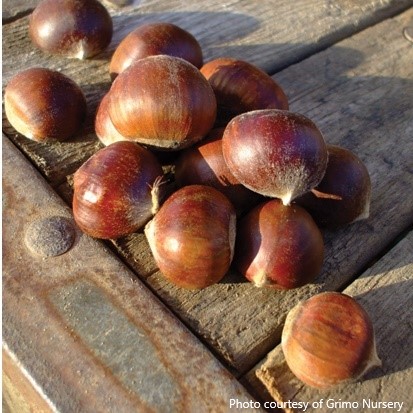Nut : CHESTNUT Chinese/American Hybrid 90-180cm (3-6') On Own Root
$49.95
(Castanea dentata x Castanea mollissima)
Native American chestnuts were once the dominant forest tree in eastern North America, sometimes attaining heights of close to 60m (200')! The lightweight, decay-resistant wood was important for timber and the low oil, high carbohydrate nuts were consumed by humans, farm animals and wildlife. In the early 1900s, a deadly fungal disease now known as ‘chestnut blight’, practically wiped out the entire American chestnut population. Much effort has gone into crossing blight-resistant Chinese chestnuts with the taller, hardier American chestnuts to bring back this valuable tree. These chestnuts crosses produce large, sweet nuts that are tastier than imported nuts. These hybrid seedlings, which are derived from superior Earl Douglass parent stock are your best bet for nut quality, hardiness and tree form as well as blight resistance. Mature height is 15-25m (50-80'). Please note that chestnut trees prefer sandy loam soil with a pH of 4.5 to 6.5.
PLANT 2 FOR POLLINATION | ZONE 4 | HARVEST: SEPT.- OCT.
Growing Tips
It is common knowledge that blueberries require acidic (low pH) soil. In many areas of Canada the soil is naturally not acidic enough (pH too high). Here we recommend our popular Blueberry Booster (see page 59). A number of other trees also prefer more acidic soil and will benefit from annual applications of Blueberry Booster. These include Chestnuts, Pawpaws and Persimmons.
Suggested Rate:
- When planting trees – 250g (1 cup) top dressed and lightly
raked in before soaking with water. - For established trees – 500g (2 cups) per 25mm (1") of tree
trunk diameter broadcast under tree in early spring.
In addition, another way to accommodate these 'special needs'
plants is to add vinegar or citric acid to their irrigation water.
(2.5 litres common white vinegar to a 20 litre bucket of water).

Only logged in customers who have purchased this product may leave a review.


Reviews
There are no reviews yet.